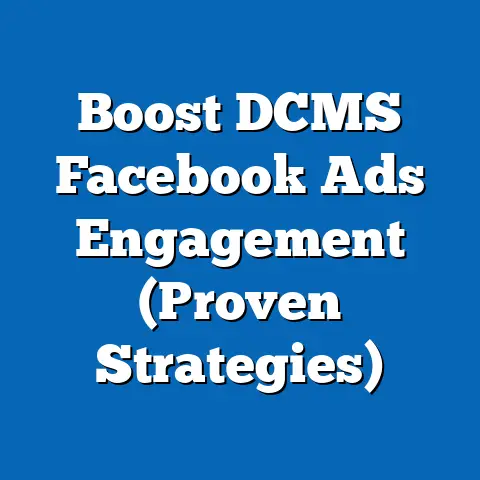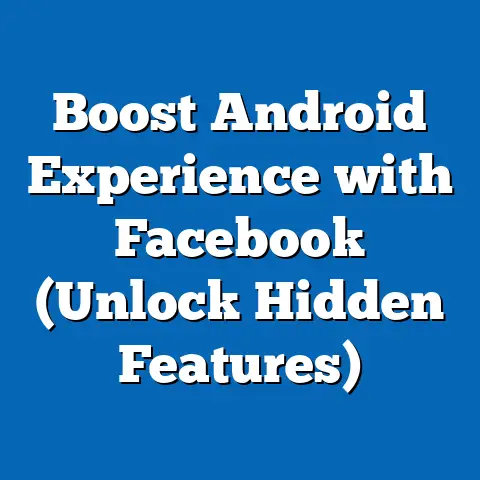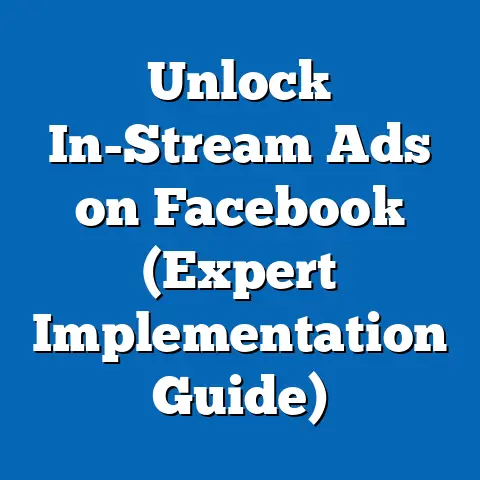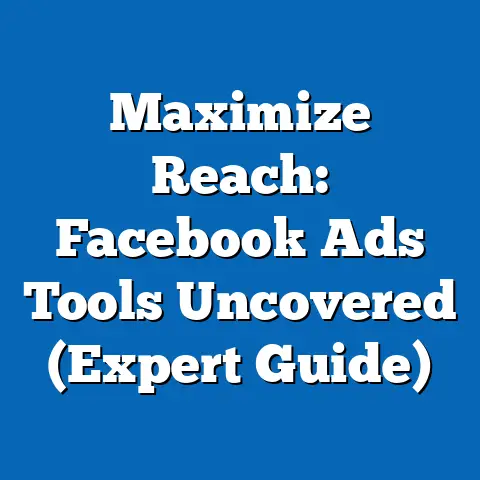Maximize Impact in New Facebook Groups (Strategic Insight)
Facebook groups. They’re everywhere, right? But have you ever stopped to think about the potential lurking within a brand-new group? As someone who’s spent years navigating the ever-evolving landscape of social media, I’ve seen firsthand how powerful these digital spaces can be, especially when they’re fresh and brimming with untapped potential. They offer a fantastic way for people to connect, share ideas, and build communities around shared interests. For brands and individuals alike, new Facebook groups represent a unique opportunity to establish a presence, foster genuine relationships, and make a real impact.
I remember when I first started experimenting with Facebook groups. I launched a small group for local photographers in my city. Initially, it was crickets. But by applying some of the strategies I’m about to share, I transformed that silent group into a thriving hub of creativity and collaboration. It became a place where photographers shared their work, asked for feedback, organized meetups, and even landed professional gigs.
This guide is all about helping you understand how to strategically approach new Facebook groups, whether you’re looking to create your own or join existing ones. We’ll dive deep into how to craft a compelling identity, build an engaged community, develop a winning content strategy, and overcome the inevitable challenges along the way. Get ready to unlock the hidden potential of new Facebook groups and turn them into powerful engines for growth and connection.
Understanding the Dynamics of New Facebook Groups
So, what exactly is a “new” Facebook group? And why should you care? Let’s break it down.
Generally, I consider a Facebook group “new” if it’s less than six months old. This timeframe is crucial because it represents a period of rapid growth and development where the group’s identity, culture, and engagement patterns are still being formed. Think of it like a startup company – the early days are critical for setting the foundation for future success.
How New Groups Differ from Established Ones:
- Higher Growth Potential: New groups often experience faster growth rates as members discover and join a previously unknown community.
- More Influence: Early contributors have a greater opportunity to shape the group’s direction and become recognized as leaders.
- Less Competition: Compared to established groups with thousands of members, new groups offer a less crowded space where your voice can be heard.
- Greater Flexibility: New groups are more adaptable and open to experimentation, allowing administrators to try different strategies and content formats.
Current Trends in User Behavior:
Before diving in, it’s essential to understand how people are using Facebook groups right now. According to Facebook’s own data, groups are a primary driver of engagement on the platform. In fact, over 1.8 billion people use Facebook groups every month. That’s a massive audience!
Here are a few key trends I’ve observed:
- Niche Communities are Thriving: People are increasingly seeking out smaller, more specialized groups where they can connect with like-minded individuals who share their passions and interests.
- Authenticity Matters: Users are drawn to groups that foster genuine connections and authentic conversations. Overly promotional or spammy groups are quickly abandoned.
- Video is King: Video content, especially live video, is incredibly engaging in group settings. It allows for real-time interaction and creates a sense of community.
- Mobile-First Experience: Most Facebook users access the platform via their mobile devices. Therefore, your group’s content and design must be optimized for mobile viewing.
The Potential Benefits of New Facebook Groups:
Joining or creating a new Facebook group can offer a wealth of benefits, including:
- Niche Targeting: New groups often focus on specific interests or demographics, allowing you to reach a highly targeted audience.
- Reduced Competition: As mentioned earlier, new groups provide a less crowded space to share your message and build relationships.
- Increased Visibility: Active participation in a new group can help you establish yourself as an expert in your field and increase your visibility among potential customers or clients.
- Direct Feedback: Groups provide a direct channel for gathering feedback on your products, services, or ideas.
- Community Building: The most significant benefit of all is the opportunity to build a loyal and engaged community around your brand or personal brand.
Takeaway: Understanding the dynamics of new Facebook groups is crucial for maximizing your impact. By recognizing the trends in user behavior and the unique potential of these communities, you can position yourself for success.
Crafting a Compelling Group Identity
Think of your Facebook group as a brand. It needs a clear identity, a compelling story, and a personality that resonates with its target audience.
Defining a Clear Purpose and Mission:
Before you even create your group, ask yourself: “Why does this group need to exist?” What problem will it solve? What value will it provide to its members?
Your group’s purpose should be clear, concise, and easily understood. For example:
- Bad: “A group for people who like things.”
- Good: “A community for amateur astronomers to share photos, ask questions, and learn about the night sky.”
A well-defined mission statement will serve as your guiding star, helping you stay focused and attract the right members.
Creating a Memorable Group Name and Description:
Your group’s name and description are the first things potential members will see. Make them count!
- Name: Choose a name that is relevant, easy to remember, and reflects the group’s purpose. Avoid overly generic or confusing names.
- Description: Write a clear and concise description that explains what the group is about, who it’s for, and what members can expect to gain by joining. Use keywords that your target audience is likely to search for.
Example:
- Name: “Sustainable Living in [Your City]”
- Description: “Join our community of eco-conscious individuals in [Your City] who are passionate about reducing their environmental impact. Share tips, resources, and inspiration for living a more sustainable lifestyle.”
The Role of Branding Within the Group:
Branding isn’t just for big corporations. It’s about creating a consistent visual identity that reinforces your group’s purpose and personality.
Building an Engaged Community
Creating a Facebook group is only the first step. The real challenge lies in building an engaged community where members feel valued, connected, and motivated to participate. I’ve found that the following strategies are crucial for fostering a thriving community.
Recruiting Initial Members:
Getting those first few members through the door is often the hardest part. Here are some effective strategies:
- Leverage Existing Networks: Start by inviting your friends, family, and colleagues to join your group.
- Utilize Social Media Platforms: Promote your group on other social media platforms like Twitter, Instagram, and LinkedIn.
- Invite Influencers: Reach out to influencers or experts in your niche and invite them to join your group. Their presence can attract new members and add credibility to your community.
- Run Facebook Ads: Consider running targeted Facebook ads to reach potential members who are interested in your group’s topic.
- Cross-Promote with Other Groups: Partner with other groups in your niche to cross-promote each other’s communities.
- Offer Incentives: Offer exclusive content, discounts, or other incentives to encourage people to join your group.
Setting Group Rules and Guidelines:
Establishing clear rules and guidelines is essential for fostering a positive and respectful atmosphere. These rules should outline what is and isn’t acceptable behavior within the group.
- Be Clear and Concise: Write your rules in plain language that is easy to understand.
- Focus on Key Behaviors: Focus on the most important behaviors you want to encourage or discourage, such as spamming, harassment, or self-promotion.
- Enforce Consistently: Enforce your rules consistently and fairly to maintain credibility and prevent future violations.
- Make Them Visible: Post your rules prominently in the group’s description or as an announcement.
Encouraging Active Participation:
Once you’ve recruited members and established your rules, the next step is to encourage active participation. Here are some proven strategies:
- Post Polls and Questions: Ask engaging questions and create polls to spark discussions and gather feedback.
- Run Contests and Giveaways: Host contests and giveaways to incentivize participation and reward active members.
- Share User-Generated Content: Encourage members to share their own content and feature the best submissions.
- Host Live Q&A Sessions: Host live Q&A sessions with experts or influencers in your niche to provide valuable insights and answer members’ questions.
- Create Challenges: Create challenges or prompts that encourage members to participate in a specific activity or share their experiences.
- Recognize and Reward Active Members: Publicly recognize and reward active members to show your appreciation and encourage others to participate.
Takeaway: Building an engaged community takes time and effort, but it’s well worth the investment. By recruiting the right members, setting clear rules, and encouraging active participation, you can create a thriving community that provides value to its members and helps you achieve your goals.
Content Strategy for New Facebook Groups
Content is the lifeblood of any Facebook group. A well-crafted content strategy is crucial for keeping members engaged, attracting new followers, and achieving your group’s objectives.
Developing a Content Calendar:
A content calendar is a schedule that outlines what content you will post, when you will post it, and on which platforms you will post it. This helps you stay organized, consistent, and focused on your content goals.
- Identify Key Themes: Determine the main themes or topics that you want to cover in your group.
- Brainstorm Content Ideas: Generate a list of specific content ideas that align with your key themes.
- Schedule Your Posts: Schedule your posts in advance using a tool like Facebook’s scheduling feature or a third-party social media management platform.
- Track Your Results: Monitor your content performance and adjust your calendar accordingly.
Types of Content That Resonate Well:
Not all content is created equal. Some types of content are more likely to resonate with Facebook group members than others.
- Video Content: As mentioned earlier, video is king. Share videos that are informative, entertaining, or inspiring.
- Live Sessions: Host live sessions to interact with your members in real-time and answer their questions.
- User-Generated Content: Encourage members to share their own content and feature the best submissions.
- Informative Posts: Share articles, blog posts, and other resources that provide valuable information to your members.
- Inspirational Posts: Share quotes, stories, and other content that inspires your members to achieve their goals.
- Behind-the-Scenes Content: Give your members a glimpse behind the scenes of your business or personal life.
- Interactive Content: Create polls, quizzes, and other interactive content that encourages members to participate.
Balancing Promotional Content with Valuable Posts:
It’s important to strike a balance between promotional content and valuable, informative posts. Overly promotional groups are quickly abandoned by members.
- Follow the 80/20 Rule: Aim to make 80% of your content valuable and informative, and only 20% promotional.
- Focus on Providing Value: Always prioritize providing value to your members. If your content is helpful and engaging, they will be more receptive to your promotional messages.
- Be Transparent: Be transparent about your promotional intentions. Don’t try to trick your members into buying something they don’t need.
- Offer Exclusive Deals: Offer exclusive deals or discounts to your group members as a reward for their loyalty.
Takeaway: A well-crafted content strategy is essential for keeping members engaged and achieving your group’s objectives. By developing a content calendar, focusing on content that resonates well, and balancing promotional content with valuable posts, you can create a thriving community that provides value to its members and helps you achieve your goals.
Leveraging Facebook Features for Maximum Impact
Facebook offers a range of features that can enhance group interaction and engagement. Mastering these features is crucial for maximizing your impact and creating a vibrant community.
Enhancing Interaction with Facebook Features:
- Events: Use the Events feature to promote upcoming events, workshops, or webinars related to your group’s topic.
- Announcements: Use the Announcements feature to highlight important information, such as new rules, upcoming events, or special offers.
- Polls: Use the Polls feature to gather feedback from your members and spark discussions.
- Units: Organize your group’s content into Units to make it easier for members to find what they’re looking for.
- Topics: Create Topics to categorize discussions and make it easier for members to find relevant conversations.
- Group Insights: Use the Group Insights feature to track your group’s performance and identify areas for improvement.
The Importance of Facebook Live:
Facebook Live is a powerful tool for creating real-time engagement opportunities.
- Host Q&A Sessions: Host live Q&A sessions with experts or influencers in your niche to provide valuable insights and answer members’ questions.
- Demonstrate Products or Services: Demonstrate your products or services live to show members how they work and answer their questions.
- Share Behind-the-Scenes Content: Share behind-the-scenes content live to give your members a glimpse into your business or personal life.
- Interview Guests: Interview guests live to provide diverse perspectives and insights to your members.
- Announce News or Updates: Announce news or updates live to keep your members informed and engaged.
Using Analytics Tools:
Facebook provides a range of analytics tools that can help you measure your group’s engagement and adjust your strategies accordingly.
- Track Your Growth: Monitor your group’s membership growth to see how many new members you’re attracting.
- Analyze Engagement Metrics: Analyze your engagement metrics, such as likes, comments, and shares, to see which content is resonating with your members.
- Identify Top Contributors: Identify your top contributors to recognize and reward them for their participation.
- Understand Demographics: Understand your members’ demographics to tailor your content and marketing efforts to their interests.
- Track Referral Sources: Track your referral sources to see where your new members are coming from.
Takeaway: By leveraging Facebook’s features and using analytics tools to track your performance, you can maximize your impact and create a thriving community that provides value to its members and helps you achieve your goals.
Building Partnerships and Collaborations
No group is an island! Building partnerships and collaborations can significantly expand your reach, credibility, and engagement.
Identifying Potential Brand Partnerships:
Look for brands that align with your group’s values and target audience. Consider brands that offer products or services that would be of interest to your members.
- Research Potential Partners: Research potential partners to learn more about their products, services, and marketing strategies.
- Identify Shared Values: Look for brands that share your group’s values and mission.
- Consider Target Audience: Choose brands that target a similar audience to your group.
- Reach Out and Connect: Reach out to potential partners and introduce yourself and your group.
Collaborating with Other Groups or Influencers:
Collaborating with other groups or influencers can help you reach a wider audience and add credibility to your community.
- Cross-Promote Each Other’s Groups: Partner with other groups in your niche to cross-promote each other’s communities.
- Host Joint Events or Webinars: Host joint events or webinars with other groups or influencers to provide valuable content to your members.
- Create Collaborative Content: Create collaborative content, such as blog posts, videos, or infographics, with other groups or influencers.
- Guest Post on Each Other’s Blogs: Guest post on each other’s blogs to reach a wider audience and share your expertise.
- Offer Exclusive Deals to Each Other’s Members: Offer exclusive deals or discounts to each other’s members as a reward for their loyalty.
Examples of Successful Collaborations:
- A fitness group partners with a local gym to offer exclusive discounts to its members.
- A cooking group collaborates with a food blogger to host a live cooking demonstration.
- A photography group partners with a camera store to offer a workshop on photography techniques.
Takeaway: Building partnerships and collaborations can significantly expand your reach, credibility, and engagement. By identifying potential partners, collaborating with other groups or influencers, and learning from successful collaborations, you can create a thriving community that provides value to its members and helps you achieve your goals.
Navigating Challenges in New Facebook Groups
Let’s be honest, starting a new Facebook group isn’t always smooth sailing. You’re bound to encounter challenges along the way. Knowing how to anticipate and address these challenges is crucial for long-term success.
Common Challenges Faced by Administrators:
- Low Engagement: Low engagement is a common challenge, especially in the early stages of a new group.
- Member Retention: Retaining members can be difficult, especially if they’re not finding value in the group.
- Spam and Self-Promotion: Spam and self-promotion can be a major problem in Facebook groups.
- Negative Behavior: Negative behavior, such as harassment, bullying, or trolling, can disrupt the community and drive members away.
- Time Commitment: Managing a Facebook group can be time-consuming, especially if you’re doing it alone.
Addressing Negative Behaviors or Conflicts:
- Enforce Your Rules: Enforce your rules consistently and fairly to prevent future violations.
- Moderate Content: Moderate content regularly to remove spam, self-promotion, and negative behavior.
- Communicate Clearly: Communicate clearly with members who violate your rules and explain why their behavior is unacceptable.
- Ban Repeat Offenders: Ban repeat offenders from the group to protect the community.
- Encourage Positive Behavior: Encourage positive behavior by recognizing and rewarding active members.
The Importance of Adaptability:
The Facebook landscape is constantly evolving. It’s important to be adaptable and willing to adjust your strategies as needed.
- Stay Up-to-Date: Stay up-to-date on the latest Facebook features and best practices.
- Experiment with New Strategies: Experiment with new strategies to see what works best for your group.
- Listen to Your Members: Listen to your members’ feedback and make changes based on their suggestions.
- Be Patient: Building a thriving community takes time and effort. Be patient and don’t get discouraged if you don’t see results immediately.
Takeaway: Navigating challenges is an inevitable part of managing a Facebook group. By anticipating common challenges, addressing negative behaviors, and being adaptable, you can overcome obstacles and create a thriving community that provides value to its members and helps you achieve your goals.
Conclusion: Turning Potential into Reality
New Facebook groups are more than just digital gathering places; they’re incubators for communities, platforms for influence, and opportunities for profound connection. By understanding their dynamics, crafting a compelling identity, building an engaged community, implementing a strategic content plan, leveraging Facebook’s features, fostering partnerships, and addressing challenges head-on, you can transform a fledgling group into a powerful asset.
I’ve seen firsthand the transformative power of these strategies. Remember that local photography group I mentioned earlier? It’s still thriving today, years later, and has become a vital resource for photographers in my city. It’s a testament to the power of community building and the potential of new Facebook groups.
Don’t just view these groups as promotional tools. See them as opportunities to build genuine relationships, foster loyalty, and create something truly meaningful.
Call to Action: Take the Leap!
Ready to unlock the potential of new Facebook groups? Take the first step today! Whether you’re creating a new group or revitalizing an existing one, use the strategies outlined in this guide to maximize your impact.
Share your experiences and insights in the comments below. What are your biggest challenges? What strategies have worked for you? Let’s learn from each other and build thriving communities together!
And if you’re looking for personalized guidance on maximizing your Facebook group impact, connect with me – I’m always happy to help! Let’s turn your vision into a vibrant, engaged, and impactful reality.






